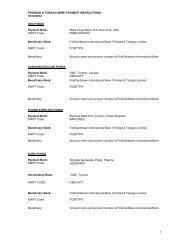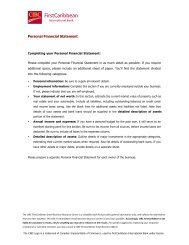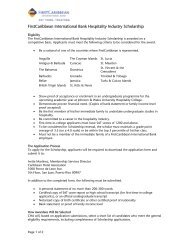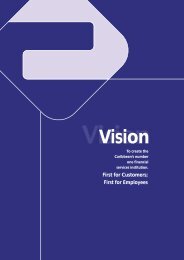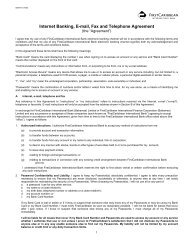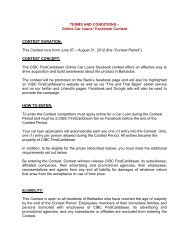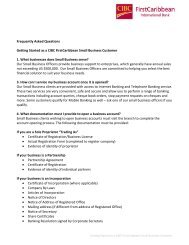Bahamas - FirstCaribbean International Bank
Bahamas - FirstCaribbean International Bank
Bahamas - FirstCaribbean International Bank
Create successful ePaper yourself
Turn your PDF publications into a flip-book with our unique Google optimized e-Paper software.
Notes to the Consolidated Financial Statements<br />
October 31, 2007<br />
(expressed in thousands of Bahamian dollars)<br />
2. Summary of significant accounting policies (continued)<br />
2.14 Goodwill<br />
Goodwill represents the excess of the cost of an acquisition over the fair<br />
value of the net identifiable assets of the acquired subsidiary undertaking at<br />
the date of acquisition and is reported in the balance sheet as an intangible<br />
asset. Goodwill is tested annually for impairment and carried at cost less<br />
accumulated impairment losses. Goodwill is allocated to lowest levels for<br />
which there are separately identifiable cash flows (cash-generating units) for<br />
the purpose of impairment testing. An impairment loss is recognised for the<br />
amount by which the asset’s carrying value exceeds its recoverable amount.<br />
The recoverable amount is the higher of an asset’s fair value less costs to sell<br />
and value in use.<br />
2.15 Property and equipment<br />
Land and buildings comprise mainly branches and offices. All property and<br />
equipment are stated at historical cost less accumulated depreciation. Historical<br />
cost includes expenditure that is directly attributable to the acquisition of the<br />
items. Changes in the expected useful life are accounted for by changing<br />
the amortisation period or method, as appropriate, and treated as changes in<br />
accounting estimates.<br />
Subsequent costs are included in the asset’s carrying amount or are recognised<br />
as a separate asset, as appropriate, only when it is probable that future<br />
economic benefits associated with the item will flow to the <strong>Bank</strong> and the cost<br />
of the item can be measured reliably. All other repairs and maintenance are<br />
charged to the consolidated statement of income during the financial period<br />
in which they are incurred.<br />
Land is not depreciated. Depreciation on other assets is computed using the<br />
straight-line method at rates considered adequate to write-off the cost of<br />
depreciable assets, less salvage, over their useful lives.<br />
The annual rates used are:<br />
Buildings 2½%<br />
Leasehold improvements<br />
10% or shorter life of the lease<br />
Equipment, furniture and vehicles 20 – 50%<br />
See Auditors’ Report Page 56.<br />
Assets that are subject to depreciation are reviewed for impairment whenever<br />
events or changes in circumstances indicate that the carrying amount may<br />
not be recoverable. Where the carrying amount of an asset is greater than<br />
its estimated recoverable amount, it is written down immediately to its<br />
recoverable amount. The asset’s recoverable amount is the higher of the<br />
asset’s fair value less costs to sell and the value in use.<br />
Gains and losses on disposals are determined by comparing proceeds with<br />
carrying amounts and are recognised in ‘other operating income’ or ‘other<br />
operating expenses’ within the consolidated statement of income.<br />
2.16 Leases<br />
Operating lease payments are recognised as an expense on a straight-line<br />
basis over the lease term and included in ‘other operating expenses’.<br />
2.17 Provisions<br />
Provisions are recognised when the <strong>Bank</strong> has a present legal or constructive<br />
obligation as a result of past events, it is more than likely that an outflow<br />
of resources embodying economic benefits will be required to settle the<br />
obligation, and a reliable estimate of the amount of the obligation can be<br />
made.<br />
2.18 Retirement benefit obligations<br />
i) Pension obligations<br />
The <strong>Bank</strong> operates a pension plan, the assets of which are held in a separate<br />
trustee-administered fund. The pension plan is funded by payments from<br />
employees and the <strong>Bank</strong>, taking account of the recommendations of<br />
independent qualified actuaries. The plan has defined benefit sections<br />
and a defined contribution section.<br />
A defined benefit plan is a pension plan that defines an amount of pension<br />
benefit to be provided, usually as a function of one or more factors such<br />
as age, years of service or compensation. A defined contribution plan<br />
is a pension plan under which the <strong>Bank</strong> pays fixed contributions into a<br />
separate entity (a fund) and will have no legal or constructive obligations<br />
to pay further contributions if the fund does not hold sufficient assets to<br />
pay all employee benefits relating to employee service in the current and<br />
prior periods.<br />
69



